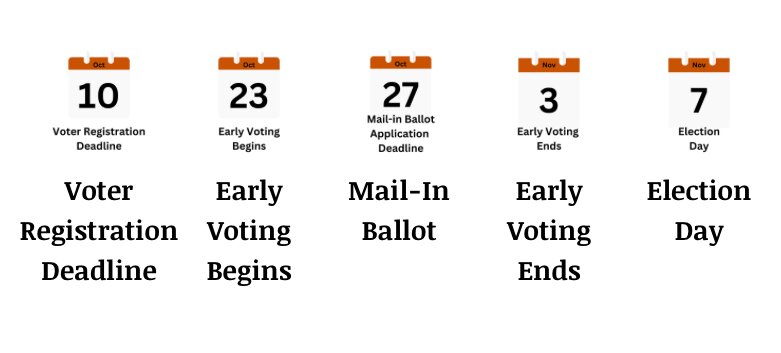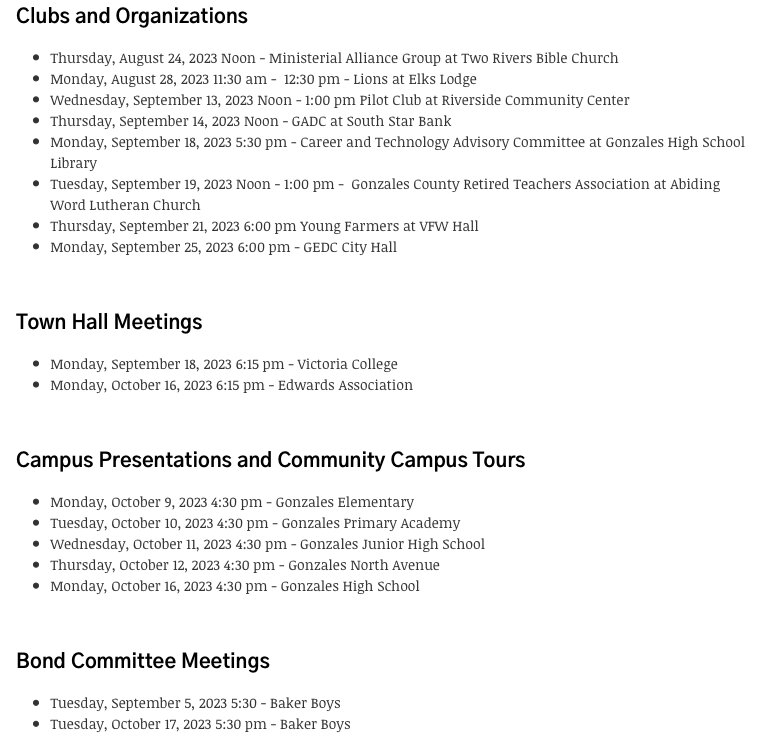GISD outlines bond issue facts in informational meeting
Members of the Gonzales Independent School District’s executive leadership team presented facts and figures regarding the district’s combined proposed $95.08 million bond package during an informational meeting Tuesday, Sept. 5, at Baker Boys BBQ.
Highlights of the two bond propositions to be voted on during the Nov. 7 election include construction of a new career and technical education building and Ag barn on land the district owns on Stieren Road as well as a new athletic complex featuring a 7,000-seat artificial turf football and soccer stadium as well as new facilities for tennis, baseball, softball and track and field.
Money will also be used to perform renovations and upgrades, especially for safety and security as well as infrastructure improvements, at all five school campuses, the administration building, maintenance and transportation.
Superintendent Dr. Elmer Avellanada said the bond election “is going to hit every one of our campuses.”
“There are designated projects for each one of our campuses. Some campuses are going to be touched and renovated and upgraded more than others,” Avellanada said. “At high school, we're asking for over $10 million of renovations at the high school, whereas, at GPA, not so much. Why is that? Well, GPA is the newest campus and it doesn't need as much as the high school, but each one of our campuses is going to get touched and renovated.”
Avellaneda said the projects being proposed were identified by a Long Range Facilities Planning Committee which began discussing district needs even before he became superintendent a year and a half ago.
“We looked at every single one of your notes that you'd left behind for me and my team,” Avellaneda said. “All the work that you did — we took that into consideration. Now some of those projects are not on the list because (Operations Director) Gene (Kridler) and his crew took it upon themselves to go ahead and complete some of those projects. But, for the most part, all the projects that ended up in the Long Range Facilities Planning recommendations are on here.”
Avellaneda said one notable absence from the recommendations of the Long Range Planning Committee is the construction of a new 1,200-student high school, which would cost an estimated $144 million.
“Do we need a new high school? Yes, we need the high school. We do. But the reason we didn't put the high school on the bond is because we need more time for planning,” Avellanada said. “If we would have put in place the High School on the proposal, it would have maximized our bond capacity. We have a max capacity of $207 million that we can go and ask for; adding the high school would have placed us at $205 million — $2 million short of our max capacity.
“Hypothetically, let's say we were to put the high school on there, and some disaster, some natural disaster, or an 18-wheeler cruising down the street hits North Avenue. We can't go and ask for more monies. We would be in a very, very difficult predicament.”
The two propositions on the ballot are Proposition A, which is for $50.6 million and includes the renovations as well as the new CTE building and Ag barn, and Proposition B, which is for $44.48 million and is for the new athletic complex.
“We're not trying to hide anything,” Avellaneda said. “The reason why we split it up into two propositions is because of state law. The TEA forces us to split up anything to do with sports complexes, so that's why it's split up into two propositions. That's what we're asking for the CTE, Ag barn, renovation, safety and security on A, and in a whole separate proposition B, the athletic complex.”
“I'm not here to sway you one way or the other,” Avellanada added. “My team that's going to be presenting with me, they're not here to sway you one way or the other. We're here just to provide the facts. You are all voters and my goal is to make sure that each one of you is educated on the upcoming bond. That's it.”
Hypothetically, should the two propositions both fail, the district will still have a mandate to provide educational and other services to its students.
“What happens then is we continue to function,” Avellenada said. “Those students are still going to come to the schools, they're still going to walk into our classrooms, they're still going to need love — somebody to teach them how to read and math. We continue to function as is, but that doesn't take away what we're asking for from the community”
Proposition A
Erin Lindemann-LaBuhn, GISD executive director of state and federal programs, said the new 26,000 square foot facility would be built at what is a potential new high school site on property the district owns on County Road 239, also known as Stieren Road.
“It would include our welding program, auto technology, culinary with our commercial kitchen, and including classrooms,” said Lindemann-LaBuhn. “All of the CTE programs that we're utilizing now, we would plan to keep those in place. The second piece is an Ag barn that would also be located at the potential new high school site and would include 10 covered pens and 10 exterior pens, which would allow our FFA students in the community who don't have the land and facilities where they live to be able to house projects on a school site.”
Lindemann-LaBuhn said 95 percent of currently enrolled high school students are enrolled in at least one career and technology class, while 75 percent are enrolled in two or more.
“What those facts tell us are that Gonzales ISD students are interested in and see the benefit of our CTE programs,” she said.
Kridler said there is a big need for renovations to be done at all campuses, especially at the high school, which was built in the 1960s, and at Gonzales Junior High as well.
“The majority of the buildings in our district — the average age is about 40 years old,” Kridler said. “Industry professionals tell us that the life cycle of a building could last upwards of 50 plus years, which is great. But the things that they put in those buildings, you know, 30, 40, 50 years ago, have to be replaced, like mechanical, electrical, engineering and plumbing.”
Kridler said the Texas Association of School Boards, or TASB, did a facility assessment two years ago that is being used to determine what needs to be addressed at the school campuses. However, if the bond passes, he said the district will “bring in design professionals, and look at all the things that were done two years ago, and reassess it.”
“Possibly, there might be other projects that need to come up and replace some of those others — some that might have a higher priority need,” Kridler said.
Some of the biggest areas of need include the old gymnasium at the high school, which lacks ADA accessibility for those in wheelchairs, as well as the tar and rock high school roof, which was last addressed in 1994 — 29 years ago.
Avellenada said the district will use some of Proposition A to renovate a portion of the old East Avenue campus (now currently the administration facility) to create a district alternative education campus so the district no longer has to pay to bus students who misbehave to Nixon-Smiley CISD.
“Throughout the whole process, we discussed that those are our students,” Avellenada said. “We really don't need to be busing them somewhere else. We need to keep our students here and provide them the resources that they need to be successful.”
Proposition B
Athletic director Joey Rivera said Proposition B calls for the creation of a new high school athletic complex at the Stieren Road property that would “allow us to bring our athletic facilities up to date.”
It includes the construction of a new 7,000-seat lighted artificial turf stadium for football and soccer with an eight-lane track and all field events, concessions and ADA-compliant bleachers, partial locker rooms, restrooms, parking and scoreboards.
There would also be stadiums for baseball and softball with artificial turf and lighting as well as eight new lighted tennis courts and a weight room for training. The tennis courts and track would allow the district to host competitions in those sports with other schools that it currently cannot do.
The new football stadium would replace Apache Field — which sits on property owned by the city — and would allow the district to move away from grass, which is costlier to maintain.
Out of 190 4A schools in the state, 168 have artificial turf fields — leaving Gonzales currently among just 22 schools of similar size that rely upon a grass field for football.
“It's really for the flexibility of everything,” Rivera said. “It's not just for athletics — you're looking at the band being able to access that field at all times. When weather happens, it causes a major scheduling issue as well. There is tons of flexibility with it, especially just being able to use it all the time, and the wear and tear and the maintenance on it is one of the great things with turf that we would see for football, baseball and softball.”
Plans for a possible $9.8 million indoor practice facility were nixed due to the cost and the space it would take up on the district’s debt level, similar to the new high school, Avellenada said.
Impact and early voting
Chief financial officer Amanda Smith said the annual tax impact on a homeowner with an assessed value of $175,000 would be $114.50 per year, or about $9.50 extra per month, based upon an understanding that a proposed constitutional amendment raising the state’s homestead exemption from $40,000 to $100,000 also will be approved by voters on the Nov. 7 ballot.
“Everyone who I’ve spoken to is assuming that legislation is going to pass, so much so that when the legislators passed that law, they told the tax assessor-collectors to generate those bills that will go out in October by assuming that is going to go into effect,” Smith said.
She said the district’s tax rate has dropped more than 35 cents during the past five years and the district has maintained the second-lowest tax rate of school districts within the area. Passage of the total bond package would increase the proposed 2023 tax rate by 15.27 cents using current property value.
“We're estimating that property value growth is going to slow down because we operate with a conservative financial mindset,” Smith said. “We're assuming a growth rate of 5 percent, four percent, three percent, two and the one over the next five years. However, the last few years, we’ve experienced property tax growth at upwards of 25 percent, so we’re using conservative estimates when we run this projection.”
Smith noted that home owners over the age of 65 or those who are disabled have their property taxes frozen, “so whether these propositions pass or fail, your tax bill will not be impacted as a taxpayer.”
Avellenada noted that Oct. 10 is the registation deadline for the bond election and early voting begins on Oct. 23.
Comments











